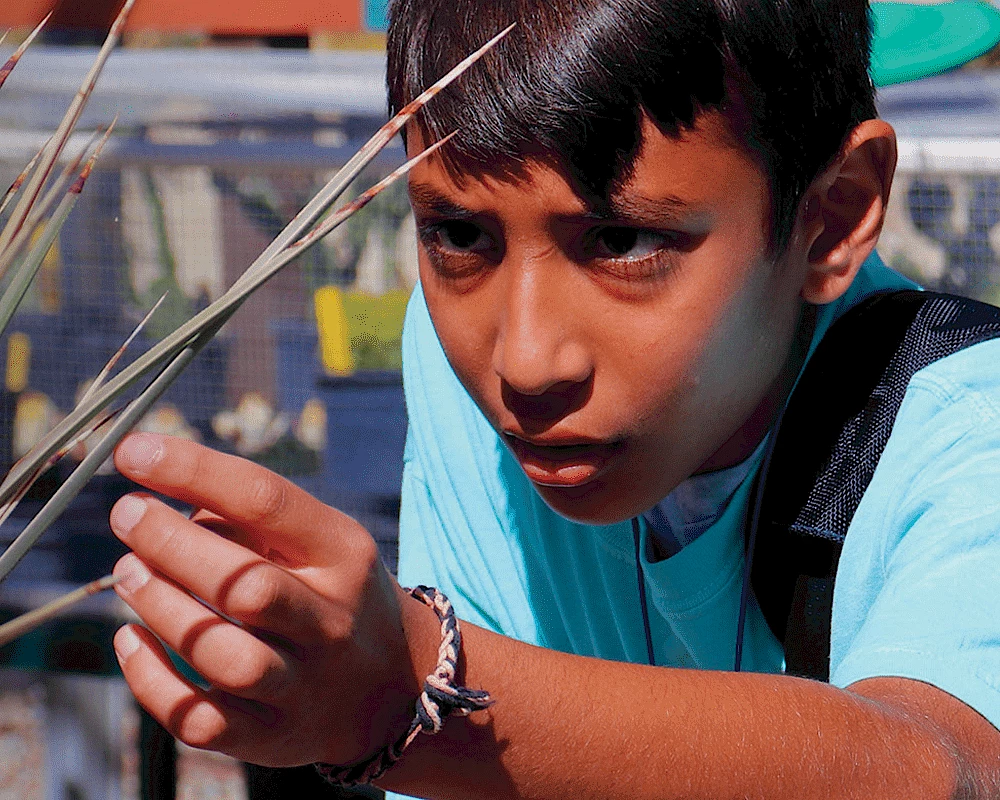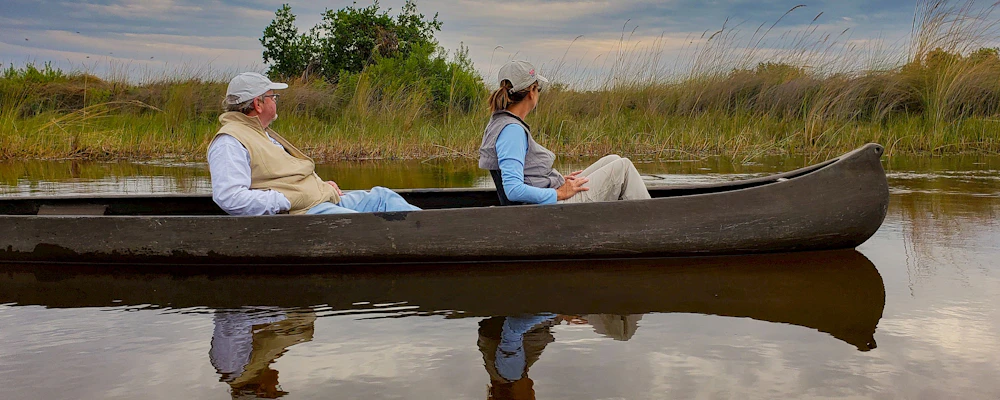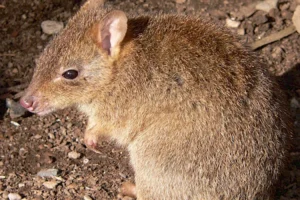Visitor Information
Australian Adventures
All the wonders of Australia’s unique deserts, none of the jet lag.
Overview
Step into the immersive Australian Adventures habitat at The Living Desert, where you can get a unique, up-close look at Australian wildlife and native plants. You’ll begin your journey with a face-to-face meeting with iconic emu, who might be seen splashing in their ponds or running to greet each other. Then, enter the immersive walkabout habitat where wallabies hop on by, budgies fly overhead, and laughing kookaburra sing.
Hop to the Land Down Under

Relax in the Outback
Set within a nearly one-acre footprint, Australian Adventures highlights some of the incredible biodiversity of Australia’s deserts. There are no barriers on the walkabout path, so the animals may even come for a closer look.

Don't Forget a Snack!
Experience dining with a wild twist at Kookaburra Cafe, serving fresh bites and kids’ favorites. Venture onto the patio to dine with a view of the habitat!
Animals You May See
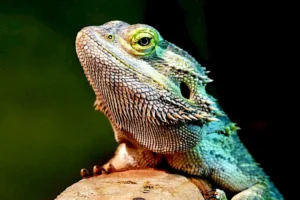
Bearded Dragon
Species Name:Pogona vitticeps
This mid-sized stocky arboreal lizard has prominent spines along its sides, a large triangular head and a spiny jaw pouch that looks like a beard when swollen. The color on its…
Read MoreFamily
Agamidae, the agama lizard family.
Conservation status
None.
Range
Central Australia.
Habitat
Desert to semi-arid woodland.
Highlights
The name “dragon” comes from the color of the interior of the mouth. When opened, it gives the appearance of breathing fire. This action is used to deter predators or male rivals during the breeding season.
This mid-sized stocky arboreal lizard has prominent spines along its sides, a large triangular head and a spiny jaw pouch that looks like a beard when swollen. The color on its upper parts varies from shades of brown, gray, reddish-brown to bright orange while the ventral surface ranges from pale to dark gray with white elongated spots edged with black.
Mature males have dark beards that become black during courtship and breeding. Adults can grow up to 2 ft. in length, the tail accounting for more than half of this and males are larger than females. They are omnivores, consuming many types of insects, small vertebrates and vegetation including fruits and flowers. They are preyed on by dingos and monitor lizards. They reach sexual maturity at one to two years of age and females lay clutches of from 11-30 leathery oblong-shaped eggs in early summer in nests dug in sandy soil. The young hatch unattended three months later. Forming a shield-like structure around the snout is a spiny jaw pouch which, when inflated, looks like a beard and is used in courtship displays as well as to deter predators from attacking.
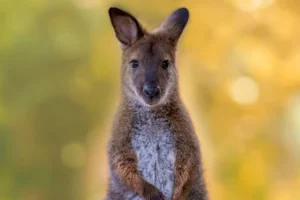
Bennett’s Wallaby
Species Name:Macropus rufogriseus
Bennett’s wallaby is a member of the macropod family. Macropod means “large foot” and refers to a family of marsupials including kangaroos and pademelons native to Australia. Well-developed males tend to…
Read MoreConservation status
Least Concern.
Range
This medium-sized wallaby is found in eastern Australia, from Queensland to South Australia. It can also be found in Tasmania.
Habitat
Bennett’s wallaby inhabits eucalypt forests, coastal shrublands, and grazing fields.
Bennett’s wallaby is a member of the macropod family. Macropod means “large foot” and refers to a family of marsupials including kangaroos and pademelons native to Australia.
Well-developed males tend to be aggressive with each other and they fight by ‘boxing’. When these wallabies feel threatened, they stamp their feet to alert others. They can also communicate using their ears, scent marking, and some vocalizations like growling and hissing.
Bennett’s wallaby has grey to reddish fur coloration, white cheek markings, and a patch of reddish fur on the neck. It has a white or light grey abdomen and a dark brown muzzle. Its head-body length reaches up to 40 inches, males being generally larger than females. Its ears are longer in proportion to other wallaby and kangaroo species and can turn to the side, which contributes to its keen hearing.
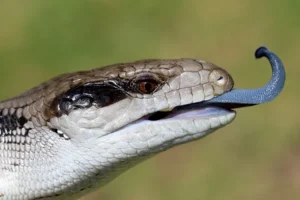
Blue-Tongued Skink
Species Name:Tiliqua scincoides
The blue-tongue skink spends most of the day searching for food. Although it is slow-moving, its brown-banded body helps it camouflage into the surrounding landscape. When threatened, blue-tongue skinks open their…
Read MoreFamily
Scincidae
Conservation status
Least Concern
Range
Northern Australia
Habitat
Grasslands, shrublands, savannas, forests
Highlights
Blue-tongued skinks are threatened by habitat loss, increasing wildfires due to climate change, agricultural toxins, and predation by foxes, dogs, and feral cats.
The blue-tongue skink spends most of the day searching for food. Although it is slow-moving, its brown-banded body helps it camouflage into the surrounding landscape.
When threatened, blue-tongue skinks open their mouth wide and deploy their ultraviolet blue-tongued, sharply contrasting their pink mouth. They also flatten their body to appear larger, thereby frightening potential predators.
Blue-tongued skinks get around using a serpentine (snake-like) movement, slithering on their bellies and using their feet to push themselves along.
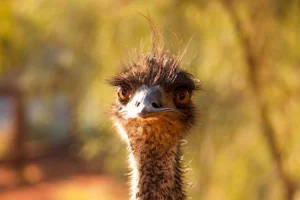
Emu
Species Name:Dromaius novaehollandiae
The emu is the second largest bird in the world and a very vocal communicator. It has a unique throat pouch, which allows it to make deep booming, drumming, grunting, and…
Read MoreConservation status
Least Conern
Range
Australia, New Guinea, Indonesia
Habitat
Grassy plains, forests, scrublands
Highlights
A Bird With Many Hidden Talents
The emu is the second largest bird in the world and a very vocal communicator. It has a unique throat pouch, which allows it to make deep booming, drumming, grunting, and even hissing sounds. Despite their size, emus are excellent swimmers and their strong legs enable them to jump up to 7 feet in the air. While running, an emu’s stride is nearly 9 feet long and they can sprint long distances, reaching speeds of up to 30 miles per hour. Although emus have wings, they are flightless. Their feathers have a unique design, which gives them a hair-like appearance and protects them from the sun.

Laughing Kookaburra
Species Name:Dacelo novaeguineae
The laughing kookaburra is the most prominent member of the kingfisher family and gets its name from its maniacal-sounding call, replicating a variety of chortles, deep laughs, and hoots. Nicknamed the…
Read MoreFamily
Alcedinidae
Conservation status
Least Concern
Range
Eastern Australia, Western Australia, Tasmania, New Zealand
Habitat
Woodlands and forests
The laughing kookaburra is the most prominent member of the kingfisher family and gets its name from its maniacal-sounding call, replicating a variety of chortles, deep laughs, and hoots.
Nicknamed the “bushman’s alarm clock” for its early dawn and dusk cackling, family groups of kookaburras live in the same territory year-round and communicate boundaries to other groups with their distinctive calls.
Laughing kookaburras can alter their loud vocalizations to find others for courtship, raising alarms, showing aggression, and begging for food.
Plants You May See
Common Mulga
Species Name:Species Name
The common mulga (Acacia aneura) is the most abundant acacia of the hot arid interior of Australia. The name mulga comes from an aboriginal word meaning “long, narrow shield” and the…
Read MoreFamily
Family
Conservation status
Conservation Status
Range
Range
Habitat
Habitat
Highlights
Highlights
The common mulga (Acacia aneura) is the most abundant acacia of the hot arid interior of Australia. The name mulga comes from an aboriginal word meaning “long, narrow shield” and the strong wood was used to make weapons such as spears and boomerangs. Mulga is a small tree typically less than 20 feet tall with grey-green foliage and cylindrical sulphur yellow flowers favored by bees followed by flat brown seed pods high in protein.
Ghost Gum
Species Name:aparrerinja
The ghost gum (Corymbia aparrerinja, formerly Eucalyptus papuana) is one of the most iconic trees of the central desert of Australia. Its common name refers to its chalk white trunk which…
Read MoreFamily
Corymbia
Conservation status
Conservation Status
Range
Range
Habitat
Habitat
Highlights
Highlights
The ghost gum (Corymbia aparrerinja, formerly Eucalyptus papuana) is one of the most iconic trees of the central desert of Australia. Its common name refers to its chalk white trunk which glows in the moonlight and was seen as evidence to the presence of living spirits. These striking trees stand out in stark contrast to the red gorges and ranges of central Australia. Ghost gums were a favorite subject of the famed Australian Aboriginal landscape artist Albert Namatjira.
Queensland Bottle Tree
Species Name:Species
The Queensland bottle tree (Brachychiton rupestris) is named after its large pachycaul trunk. The much sought-after bottle shape of the trunk is achieved after at least 5-8 years of growth and…
Read MoreFamily
Family
Conservation status
Conservation status
Range
Range
Habitat
Habitat
Highlights
Highlights
The Queensland bottle tree (Brachychiton rupestris) is named after its large pachycaul trunk. The much sought-after bottle shape of the trunk is achieved after at least 5-8 years of growth and has earned the tree the attention of succulent growers and bonsai enthusiasts. It is widely used in its native Queensland as an ornamental landscape tree for its ability to withstand drought and high temperatures. In the wild, it is an important emergent component of protected softwood scrub where it is often the tallest member of the canopy.
Accessibility
On the day of your visit, please feel free to discuss any needs you have at our Guest Services office, adjacent to the front entrance. If you have needs or questions prior to your visit, please call us at (760) 346-5694, or email us at GuestServices@LivingDesert.org.
Mobility Information
- Paved paths, with even terrain.
- Strollers and wagons must be be left outside of the habitat.
- Chairs and areas to sit are available throughout this section of the Zoo.
Sensory and Additional Information
- Service animals are not permitted in Australian Adventures.
- Features sections with heightened noise levels; use discretion.
- Home to various species of free-flying birds.
Latest News from Australian Adventures
Conservation
Many similarities exist between Californian and Australian deserts, but the continent’s geographic isolation, long geologic history, and diverse climates result in sustaining a variety of animals that are unique to Australia. Here’s how The Living Desert is working to protect biodiversity and and support these desert species.
Yellow-Footed Rock Wallaby Program
Wallabies face numerous threats in their natural habitat due to climate change, leading to a decline in their population to less than 10,000 individuals. To help preserve this species, The Living Desert works closely with the Australian government to house and breed yellow-footed rock wallabies at the Zoo. The Living Desert is honored to be the only U.S. zoo currently caring for a breeding mob of yellow-footed rock wallabies.

Studbook and Species Survival Plan
The Living Desert is dedicated to preserving the desert species of the world for future generations, but sadly many species are on the verge of extinction. To prevent losing these species forever, zoos accredited by the Association of Zoos and Aquariums (AZA) have created responsible breeding programs called Species Survival Plans® (SSPs). This strategic, scientific, and intentional process is led by species experts, several of which are at The Living Desert.
These cooperative programs are designed to maintain a healthy, genetically diverse, and demographically stable population for the long-term future and is just one way The Living Desert continues to be part of the solution to save animals from extinction.

Join Us in Our Mission to Protect Australian Deserts.

